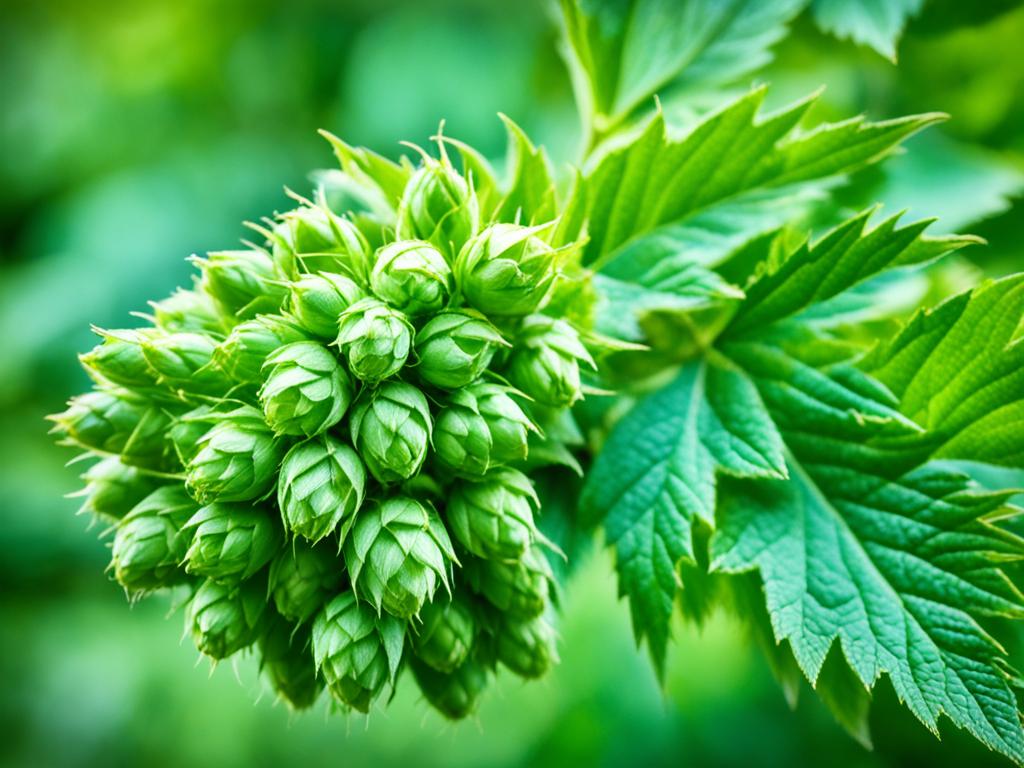Welcome to the world of beer, where hops take center stage. When it comes to brewing, hops are the unsung heroes that contribute to the essence of beer. These small, cone-shaped flowers are packed with aromatic compounds and bittering agents that infuse every sip with flavor and character. Whether you’re a beer enthusiast or curious about brewing, understanding the role of hops is crucial to appreciating the diverse and fascinating world of beer.
Throughout history, hops have played a pivotal role in the brewing process. From ancient civilizations to modern breweries, these botanical gems have been cherished for their unique ability to transform grains and water into the beloved beverage we know and love today.
So, what exactly makes hops so special? Let’s explore the basics, the varieties, and the indispensable role they play in the art of brewing. We’ll go beyond the traditional and dive into the innovative use of hops in craft beer, where boundaries are pushed and new flavors are discovered.
Key Takeaways:
- Hops are essential to the brewing process, adding both bitterness and flavor.
- There are various types of hops, each with its own unique characteristics and flavors.
- Through experimentation and innovation, brewers are constantly pushing the boundaries of what can be achieved with hops.
- Hops farming is an intricate process that requires careful attention to detail and overcoming challenges.
- By selecting the right hops, brewers can create a wide range of flavors and aromas in beer.
The Basics: Varieties of Hops and Their Characteristics
When it comes to crafting the perfect beer, one of the key ingredients that brewers rely on is hops. These small, cone-shaped flowers not only add bitterness to balance the sweetness of malt, but they also contribute unique flavors and aromas that make each beer truly special. Let’s dive into the world of hops and explore the different varieties and characteristics that define them.
Understanding Hop Varieties
In the vast world of hops, there are numerous varieties, each with its own distinct profile. These variations in hops come from differences in growing regions, terroir, cultivation techniques, and genetic makeup. Some popular hop varieties include:
- Cascade: Known for its strong floral and citrusy aroma, Cascade hops are often used in American-style ales and IPA’s.
- Centennial: With its intense floral, citrus, and pine notes, Centennial hops are a favorite in hop-forward beers.
- Simcoe: Simcoe hops offer a unique blend of earthy, piney, and tropical fruit flavors, making them versatile for a range of beer styles.
- Citra: With its unmistakable tropical fruit and citrus characteristics, Citra hops are beloved for their ability to add vibrant flavors to hoppy beers.
- Hallertau: Originating from Germany, Hallertau hops are known for their delicate and subtle floral and herbal flavors, perfect for traditional lagers.
- Amarillo: Amarillo hops are cherished for their bold orange, tangerine, and grapefruit flavors, contributing to the complexity of hoppy ales.
Hop Characteristics and Influence
Each hop variety possesses specific characteristics that can influence the flavor and aroma of beer. These characteristics include alpha acids, essential oils, and overall bitterness. Alpha acids, which are responsible for bitterness, can range from mild to high, allowing brewers to control the perceived bitterness of their beers. Essential oils, on the other hand, contribute to the aromatic qualities of hops, offering notes of fruit, spice, floral, or pine.
“Hops are the spice of beer, providing a complex range of flavors and aromas that transform a simple beverage into a sensory experience.”
The concentration of alpha acids and essential oils in hops varies depending on the variety, making some hops more suitable for bittering, while others excel at adding aroma. Brewers carefully select and combine different hop varieties to create the desired balance of bitterness, flavor, and aroma in their beers.
Understanding the characteristics of different hop varieties allows brewers to experiment and create unique brews that cater to diverse palates. Whether you’re craving a crisp and balanced lager or a hop-forward IPA bursting with tropical flavors, hops provide the versatility to craft the perfect beer for any occasion.
The Role of Hops in Brewing
When it comes to brewing beer, hops play a crucial role in shaping its flavors, bitterness, and aroma. These small cone-shaped flowers, derived from the hop plant, are responsible for adding that distinctive hoppy character to your favorite brews. But their impact goes beyond just taste. Let’s dive into the fascinating role that hops play in the brewing process.
Hops and Bitterness:
One of the primary contributions of hops to beer is bitterness. During the brewing process, hops are added to the boiling wort, the liquid extracted from malted barley. The high temperatures release alpha acids from the hops, which then react with the sugars in the wort, creating bitterness. This bitterness not only balances the sweetness of the malt but also acts as a natural preservative, extending the beer’s shelf life.
Hops and Flavor:
While hops are known for adding bitterness, they also bring a wide range of flavors to beer. Different hop varieties possess various characteristics, such as floral, citrus, pine, or spicy notes. These flavors can be subtle or bold, depending on the hop variety and the quantity used during brewing. The careful selection and combination of hops allow brewers to create a diverse array of beer flavors, from light and refreshing to rich and complex.
Hops and Aroma:
In addition to flavor, hops contribute significantly to the aroma of beer. During the brewing process, volatile compounds found in hops evaporate and infuse the beer with pleasant aromas. The hop aromas can range from fruity and tropical to earthy and herbal, adding another layer of complexity to the sensory experience of enjoying a beer.
The Art of Balancing:
Furthermore, hops play a crucial role in achieving a balanced beer. Their bitterness counters the sweetness of the malt, creating harmony and enhancing drinkability. The skillful use of hops allows brewers to strike the perfect balance between sweet and bitter, resulting in a well-rounded and enjoyable beer.
To summarize, hops are much more than a flavoring agent in beer. They act as natural preservatives, add bitterness, contribute to flavor profiles, and infuse beers with captivating aromas. The careful selection and utilization of hops have a profound influence on the overall quality and character of the final brew.
Now that we understand the crucial role that hops play in brewing, let’s explore the fascinating world of hops farming and the techniques involved in section 4.
Hops Farming: Techniques and Challenges
Hops farming is both an art and a science. To achieve a successful harvest, hops farmers employ various techniques that involve careful planning and meticulous care. Let’s explore some of the essential techniques used in hops farming, as well as the challenges faced by farmers in this industry.
Soil Preparation: Creating the ideal soil conditions is crucial for optimal hops growth. Farmers analyze soil composition and pH levels to ensure they provide the best environment for hops plants to thrive. This involves testing the soil, adding necessary nutrients, and adjusting pH levels if required.
Planting: Hops plants require proper spacing and support structures to grow effectively. Farmers carefully plant rhizomes or young hops plants, ensuring adequate spacing between plants to encourage air circulation and prevent the spread of diseases. They also install trellis systems to support the vertical growth of hops vines.
Harvesting: Timing is crucial when it comes to harvesting hops. Farmers monitor the cones closely, waiting for the perfect ripeness indicated by visual cues, aroma, and the touch test. After determining the optimal time, hops are carefully hand-picked or mechanically harvested to preserve their quality.
Pests and Diseases: Hops farming faces challenges from various pests, including aphids, spider mites, and mildew. Farmers implement integrated pest management techniques to control pests while minimizing the use of chemicals. Regular scouting, trapping, and organic pest control methods are employed to protect the hops plants from damage.
Climate Conditions: Hops are highly sensitive to climate conditions, and their growth can be greatly influenced by temperature, sunlight, and rainfall. Farmers carefully monitor weather patterns and make adjustments to irrigation and shading systems to provide the ideal microclimate for hops plants.
Table: Challenges in Hops Farming
| Challenges | Impact | Potential Solutions |
|---|---|---|
| Pests and diseases | Reduced yields and quality | Integrated pest management, regular scouting, and organic pest control methods |
| Climate variability | Unpredictable growth and yield fluctuations | Monitoring weather patterns, irrigation adjustments, and shading systems |
| Market demand | Fluctuating prices and competition | Diversifying hop varieties, establishing reliable buyer relationships |
| Labour and resources | High labor-intensive tasks and resource management | Efficient workforce management, implementing technological advancements |
Despite these challenges, hops farmers are at the forefront of the brewing industry, ensuring a steady supply of quality hops for beer production. Their dedication and passion for the craft contribute to the vibrant and diverse world of brewing.
Quote:
“Our commitment to sustainable farming practices and continuous innovation allows us to overcome the challenges faced in hops farming, ensuring we deliver the finest hops to brewers worldwide.” – John Smith, Hops Farmer
Hops in Craft Beer: Pushing the Boundaries
Hops have always played a crucial role in beer brewing, but in recent years, they have become a catalyst for innovation and experimentation in the craft beer industry. Brewers are constantly pushing the boundaries of traditional brewing by harnessing the unique qualities of hops to create brews that defy expectations and tantalize the taste buds.
One of the ways brewers are exploring the potential of hops is through their selection and combination of different hop varieties. By carefully choosing hops with diverse characteristics, brewers can unlock an array of flavors and aromas. Hops known for their citrus and tropical fruit notes can lend a refreshing and exotic twist, while those with earthy and piney qualities can evoke a sense of rugged wilderness.
But it’s not just about the types of hops used; brewers are also experimenting with innovative hop techniques to enhance the hop profile and create new sensory experiences. From dry hopping to hop bursting, these techniques involve adding hops at specific stages of the brewing process to extract maximum flavor and aroma. This meticulous attention to hops allows brewers to craft beers with unparalleled complexity and depth.
In addition to techniques, brewing styles are also being reimagined to showcase hops in new and exciting ways. Hazy IPAs, for example, have gained popularity for their intense hop character and creamy mouthfeel. These beers often feature generous hop additions during fermentation, resulting in a juicy and aromatic explosion of flavors. Brewers are also using single-hop beers to highlight the unique characteristics of individual hop varieties and showcase their full potential.
As the craft beer industry continues to evolve, so do the boundaries of what is possible with hops. Brewers are incorporating hops in unconventional ways, such as aging beer in hop-infused barrels or infusing hop oils into beer cocktails. These innovations challenge traditional notions of beer and open up endless possibilities for flavor exploration.
Recent trends in the craft beer industry highlight the growing demand for hop-forward brews. Craft beer enthusiasts are seeking out beers with bold hop profiles and exciting hop combinations. This trend is driving increased collaboration among brewers and hop farmers to develop new hop varieties with unique flavors. The resulting innovation in hops is transforming the craft beer landscape, inspiring brewers to create beers that are out of this world.
Recent Trends and Developments
The craft beer industry has witnessed a surge in hop-forward beers, with ever-increasing flavors and aromas. Brewers are constantly experimenting with new hop varieties and techniques to stay ahead of the trend. One such innovation is the use of cryo hops, which undergo a specialized freezing process to separate lupulin, the part of the hop flower that contains essential oils and resins responsible for flavor and aroma. This concentrated form of hops allows brewers to achieve intense hop character without adding excessive bitterness. Another trend is the rise of hop blends or hop tea, where brewers create unique hop combinations by blending different varieties or steeping them in hot water like a tea infusion. These developments in hop utilization showcase the creativity and ingenuity of brewers as they continue to push boundaries and redefine what is possible in the world of craft beer.
As the craft beer industry grows, the role of hops in shaping its future becomes increasingly significant. The ingenuity and unwavering commitment of brewers to push the limits of hop usage result in an ever-evolving and exciting range of flavors. Craft beer enthusiasts can look forward to more boundary-pushing innovations that challenge their palates and enrich their beer-drinking experiences.
Conclusion
In conclusion, hops are an essential ingredient in the brewing process, providing the distinctive flavors and aromas that make beer truly exceptional. From their bittering properties to their ability to enhance balance and preserve the beer, hops play a crucial role in creating a wide array of beer styles. Whether it’s the citrusy notes of Cascade hops or the floral aroma of Centennial hops, the right selection of hops can transform a brew into a sensory delight.
By exploring the various hop varieties and understanding their characteristics, brewers can craft beers that cater to different palates and preferences. The world of hops is constantly evolving, with innovative brewers pushing the boundaries of traditional brewing techniques and flavors. From hop-forward IPAs to experimental hop combinations, the possibilities are endless, ensuring that there is always something new and exciting for beer enthusiasts to enjoy.
As the craft beer industry continues to grow, hops remain at the forefront of innovation. Craft breweries around the world are experimenting with new hop varieties, refining their brewing techniques, and pushing the boundaries of what beer can be. This dedication to quality and creativity ensures that beer lovers will always have access to a diverse and evolving selection of flavors. So next time you enjoy a pint of beer, take a moment to appreciate the hops that have contributed to its unique character.







